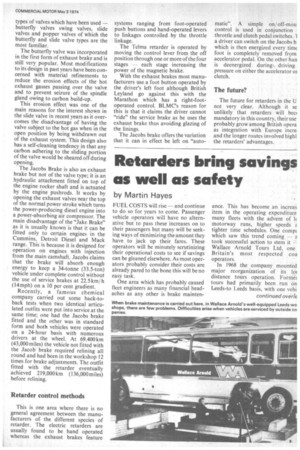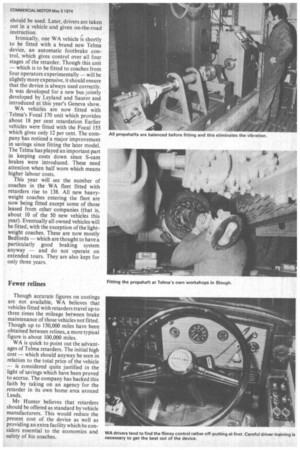Retarders bring savings as well as safety
Page 37

Page 38

Page 39

If you've noticed an error in this article please click here to report it so we can fix it.
by Martin Hayes
FUEL COSTS will rise — and continue to do so for years to come. Passenger vehicle operators will have no alternative but to pass these increases on to their passengers but many will be seeking ways of minimizing the amount they have to jack up their fares. These operators will be minutely scrutinizing their operational costs to see if savings can be gleaned elsewhere. As most operators probably consider their costs are already pared to the bone this will be no easy task.
One area which has probably caused fleet engineers as many financial headaches as any other is brake mainten ance. This has become an increas item in the operating expenditure many fleets with the advent of '1( motorway runs, higher speeds e tighter time schedules. One compe which saw this trend coming -a took successful action to stem it -Wallace Arnold Tours Ltd, one Britain's most respected coa operators.
In 1968 the company mounted major reorganization of its lot distance tours operation. Former tours had primarily been run on Leeds-to Leeds basis, with one vehi nd one driver for each tour, 1968 saw he introduction of the "linking" orinciple — using one vehicle but everal drivers to operate a number of ours in a restricted time period — and :ottsequently greatly intensified vehicle isti. The move was accompanied by the tbsorption of a Croydon-based corn)any which enabled London tour iepartures to be introduced. This meant :hat vehicles — hitherto exclusively maintained at WA's well-equipped workshops in Leeds — began spending long periods away from base. Outside maintenance rates began escalating at about the same time.
All these factors — which combined to produce conditions where brake adjustments had to be carried out two or three times per tour to one vehicle by outside compamies — caused the company to examine methods of producing some savings.
After an approach from Telma Retarder Ltd it was decided to try the company's electric retarder experimentally. The main motive was to see whether any savings in brake maintenance were possible but, of course, the enhanced safety which the device was claimed to offer was important too.
WA's 286-coach fleet is primarily made up of Leyland Leopards so it was natural to fit the device to these vehicles.
Arduous conditions
Obviously, vehicles were chosen that would operate under the most arduous conditions. A typical day's run from, say, Leeds to Torquay, some 330 miles, produces exactly the high-speed, harddriving conditions which take most out of the brakes. As brake maintenance is always carried out immediately the driver complains, this often meant work being necessary with the vehicle away from base. To complicate the problem intensive vehicle use on coach tours dictates that almost all servicing during the season is conducted at night, with Friday and Sunday being peak periods. While there is little difficulty in providing fitters on overtime at Leeds, it is nothing like so easy when using outside companies. Even if facilities can be made available costs are inevitably higher. These days simple brake adjustments — those requiring about 30 minutes work in a well-equipped workshop — can cost considerable amounts.
WA pays about £400 per vehicle for the Telma including installation by an authorized agent alongside Plaxton's works in Scarborough. The company, says Mr E. C. Baldwin, managing director, and Mr E. Hunter, the chief engineer, expects to save about £120 a year per vehicle by reduced brake maintenance. Thus the retarder should pay for itself in less than four years. The company keeps its vehicles for 10 or 12 years but is still expecting to get about a quarter of the Telma's original cost back on resale. No retarder-equipped vehicles have yet been sold but if this target £100 is not recovered there are plans to remove the device and fit it to a new vehicle. Provided close attention is paid to aligning the device there should be no technical problems. The transfer would take about a day to complete.
One of the first lessons learnt from fitment of the Telma was that proper driver tuition was essential to achieve the potential benefits. Initially the device was controlled by a single-stage switch on the footbrake pedal. Gentle pressure on the pedal operated the retarder; firmer pressure operated the service brake. Apart from the fact that most drivers tended to partially apply the service brake on initial pedal pressure — thus causing lining wear and defeating much of the object of the Telma — there was a wear problem with the contacts in the switch. Accordingly, later vehicles were fitted with the multistage, column-mounted switch. The original 16 vehicles with the foot switch were converted.
Day's tuition
Now, drivers receive a day's tuition on correct use of the retarder. This starts with a film and slides on the retarder's construction and function. Then Mr Hunter explains how the retarder should be used. Later, drivers are taken out in a vehicle and given on-the-road instruction.
Ironically, one WA vehicle is shortly to be fitted with a brand new Telma device, an automatic footbrake control, which gives control over all four stages of the retarder. Though this unit — which is to be fitted to coaches from four operators experimentally — will be slightly more expensive, it should ensure that the device, is always used correctly. It was developed for a new bus jointly developed by Leyland and Saurer and introduced at this year's Geneva show.
WA vehicles are now fitted with Telma's Focal 170 unit which provides about 18 per cent retardation Earlier vehicles were fitted with the Focal 155 which gives only 12 per cent. The cornAll propshafts are balanced before fitting and this eliminates the vibration. pany has noticed a major improvement in savings since fitting the later model. The Telma has played an important part in keeping costs down since S-cam brakes were introduced. These need attention when half worn which means higher labour costs.
This year will see the number of coaches in the WA fleet fitted with retarders rise to 138. All new heavyweight coaches entering the fleet are now being fitted except some of those leased from other companies (that is, about 10 of the 50 new vehicles this year). Eventually all owned vehicles will be fitted, with the exception of the lightweight coaches. These are now mostly Bedfords — which are thought to have a particularly good braking system anyway — and do not operate on extended tours. They are also kept for only three years.
Fewer relines
Though accurate figures on costings are not available, WA believes that vehicles fitted with retarders travel up to three times the mileage between brake maintenance of those vehicles not fitted. Though up to 150,000 miles have been obtained between relines, a more typical figure is about 100,000 miles.
WA is quick to point out the advantages of Telma retarders. The initial high cost — which should anyway be seen in relation to the total price of the vehicle — is considered quite justified in the light of savings which have been proved to accrue. The company has backed this faith by taking on an agency for the retarder in its own home area around Leeds.
Mr Hunter believes that retarders should be offered as standard by vehicle manufacturers. This would reduce the present cost of the device as well as providing an extra facility which he considers essential to the economics and safety of his coaches.




























































































